Russian squads in battle. Part of 4
The story of Old Russian weapons melee combat will be incomplete if you do not mention maces, clubs and hands. This weapon, due to its effectiveness, was very popular in a friendly environment. True, here too, fiction is often more widespread than reality. So, when they say "mace", they most often represent some large and even huge pear-shaped and, apparently, all-metal weapons that artists like to attach to the saddle or wrist to the hero Ilya Muromets. Apparently, fairy-tale heroes also played a role here, who ordered "stopudovye" maces from the blacksmiths.
Meanwhile, in reality, everything was much simpler and more efficient. The mace was iron or bronze (sometimes filled inside with lead) with a weight of 200-300 g, which was fixed on the handle with a length of 50-60 cm and 2-3 thickness. The handle was sometimes sheathed for strength with a copper sheet. According to the researchers, the mace was an auxiliary weapon of cavalry warriors and served to deliver an unexpected, quick strike in any direction. The mace seems to be a less formidable weapon than a sword or an ax, but it was an excellent auxiliary weapon. Historians report that in Ancient Russia not all battles were "to the last drop of blood." Sometimes a demonstration was enough, when a more decisive squad overturned another and the chronicler wrote down: “... and they parted ways, and there were many wounded, but few were killed”. The task was not to exterminate the enemy without exception, but to break his will to resist, to force him to retreat, to admit himself defeated. In such a battle, and needed a mace that could "stun" the enemy (stun him), knock off his horse.
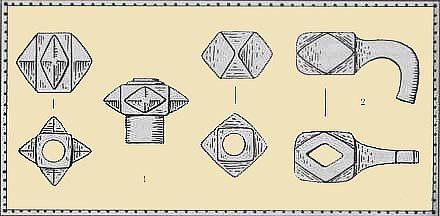
Iron clubs. (XI – XIII century): 1 - pyramid-shaped spiked maces, 2 - klevtsy maces. Source: M. Semenov. We are Slavs.
Judging by the archaeological data, the mace was also a legacy of the “steppe”. The form is the most diverse. Among the oldest finds, the tops are predominant in the form of a cube with four spikes of pyramidal shape, arranged crosswise. Sometimes the maces had a protrusion “hammer”. In the XII - XIII centuries. the cubic form of the mace was widely spread among the townspeople and rural residents: the maces were made in the form of cubes with cut corners. However, the development of this weapon went not only along the line of simplification. In the same period of time, multi-stud maces of various forms appear. In the pommel did the spikes, which protruded in different directions, to the line of impact was always one or more spikes.
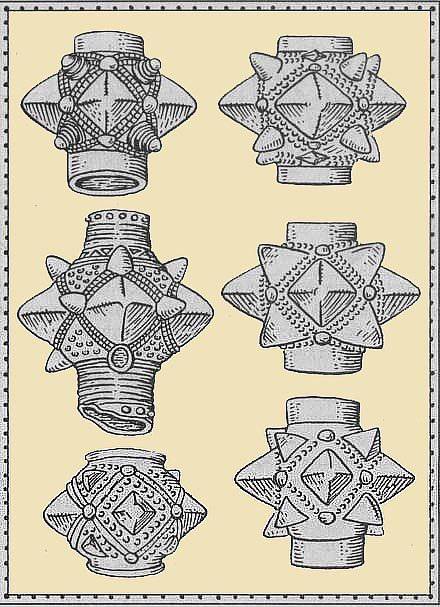
Multi-stud maces of various shapes. XI – XIII century.
In the XII - XIII centuries. one more type of clubs appears - spherical pommel, in which the ribs, intended for impact, are cut out. These were the immediate predecessors of the shestopyor - maces with six feathering ribs.
The mace, like the sword, the ax, retained the most ancient symbolism. The first mace with a stone head appeared in the Neolithic and were the heirs of primitive clubs. In the mythology of the Indo-Europeans, the mace is often a thunderous weapon. In particular, Indra, the lord of the kingdom of heaven (Svarga) in Vedic and Hindu mythology, a relative of Thor and Perun, was armed with a rod and mace (vajra). Therefore, a decorated mace, a product of a good master, could often be a symbol of power. The mace as a symbol of power has been noted by Russians, Poles, Hungarians and Turks. Around the XVI - XVII centuries. the mace is increasingly becoming not a weapon, but a symbol of power. Special ceremonial clubs decorated with gold, silver and precious stones appear. In the Cossacks, the mace was preserved until the beginning of the 20th century under the name of insects, and was a distinctive symbol of the village atamans. Mace served as a symbol of power and dignity in Turkish pasha, Polish and Ukrainian hetmans. In Poland, the mace was preserved in the 20 century, as a mark of distinction of the marshal. Currently, the mace is the official symbol of presidential power in Ukraine.
The clubs, as another legacy of primitive times, were also in the hands of the Slavs for a long time. Arabian traveler 10 century, reports that in service with the Slavs he met were clubs. They were worn at the waist, in a battle they tried to hit the enemy on the head. Sometimes they threw. A simple club could make any militia. The fighting club, which was auxiliary weapon of vigilantes, differed from the usual cudgel, lower weight, and the presence of so-called “fortifications”, that is, was bound, had iron hoops, pommel, sometimes with spikes.
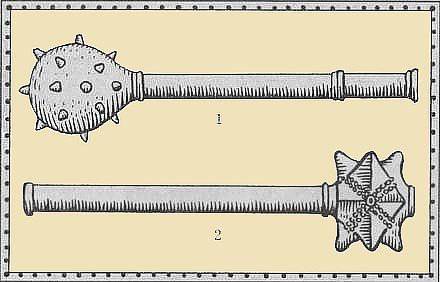
1. Mace XIII century. 2. Mace. XII century.
Another type of melee weapon, which Russia inherited from the Sarmatian-Alanian era, was the brush. They are also called "combat weight". This is a flexible-articular shock-shattering weapon. A brush is a shock load (bone, stone or metal weight - beat, weighing 100 - 300 g), which is connected by a suspension (chain, belt or strong rope) to a wooden handle - paint brush. Due to its low cost and ease of manufacture, these weapons will be massively distributed in Russia in the 10th — 17th centuries (as well as in Europe and Asia). On a more limited scale, robbers and civilians (in particular, coachmen) for self-defense, paintwork was used in the Russian Empire.
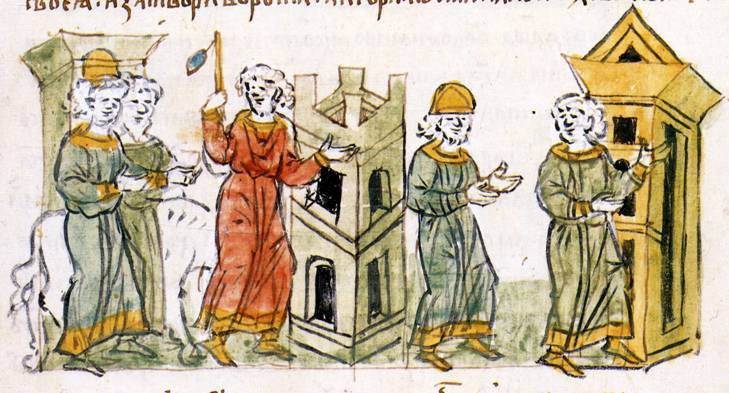
A miniature of the 15th century Radziwill chronicle, depicting the scene of the murder of Igor Olgovich. In the hands of one of the rebels depicted a brush.
The reputation of the weapon of the common people was fixed behind this weapon. Especially often the cista is considered a robber's weapon. Indeed, due to the relatively small size, but very effective, the brush could be hidden unnoticed in clothes, carried with them. As Vladimir Dal described in his dictionary: “A brush (deaf), a weight on a short brush; he was sewed up his sleeve, behind his shirt, behind his bootleg; Chisel-nazven, chainhead, core or weight on a chain, on a belt, with a chain; one-handed chainsaw, short and light; two-handed, telepen or basalyk, on a long chain; flying brush, weight on the belt, which is wound, circling, on the brush, and develops with a sweep; they also beat in two paws, o-wooher, spreading them, circling them, striking and picking them one at a time; there was no hand-to-hand attack to such a fighter. ”
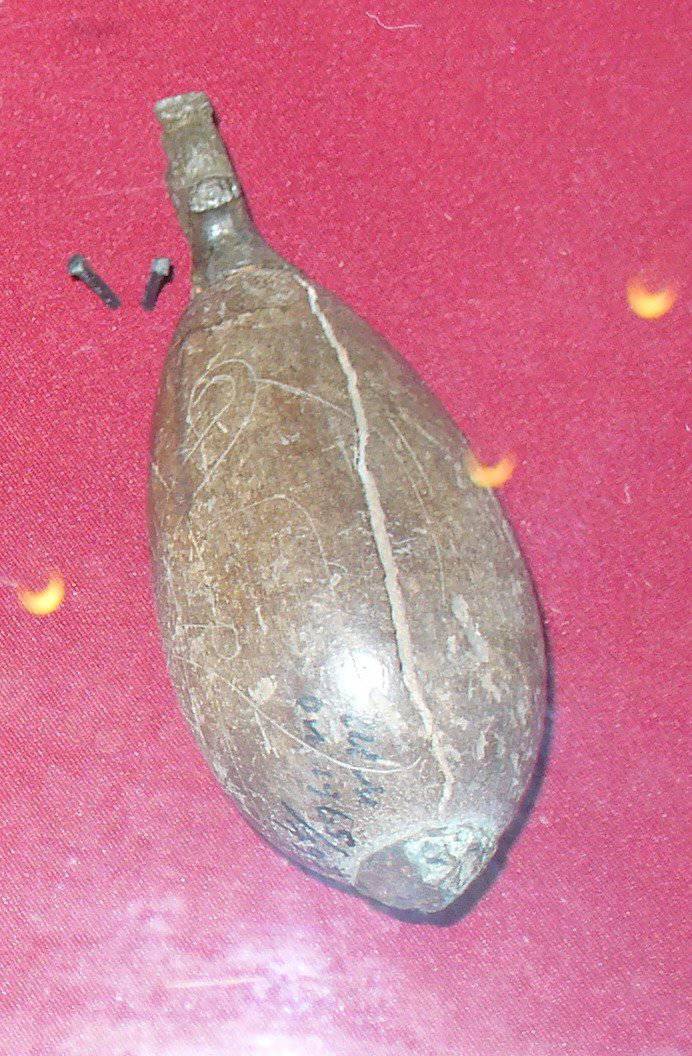
The bone beater of the brush with a metal rod fitted with a loop. Russia, XII — XIII c.
However, according to the research of A. N. Kirpichnikova (Old Russian Weapons. Issue 2. Spears, Sulits, Battle Axes, Maces, Treasures of the 9th — 13th Centuries; Kirpichnikov A.N. Medvedev A. Armament // Ancient Russia. City Castle. Village. M., 1985 g.), In the period X - XIII centuries. The brush was the weapon of an equestrian vigilante. Kisten, like a mace, a mace, served as an auxiliary weapon. In a fleeting fight, they could strike a sudden and quick blow. So, on some weights princely signs are carved - tamgas, which indicates that they belong to a warmer environment. In addition, weights are often well decorated. In the period of the greatest distribution - XII — XIII centuries. brushes were used throughout Russia, from Kiev and Chernigov to Novgorod. The kisteni remained the weapon of the Russian cavalry until the end of the 16 century, and in the XXUMX century similar weapons, to some extent, still retained their combat mission. So, in the inventory of the armory of the Kirilo-Belozersky monastery 17 of the year, among other things, it is reported about "one hundred and sixty iron cages." At the same time, the fetish was a weapon common to ordinary people.
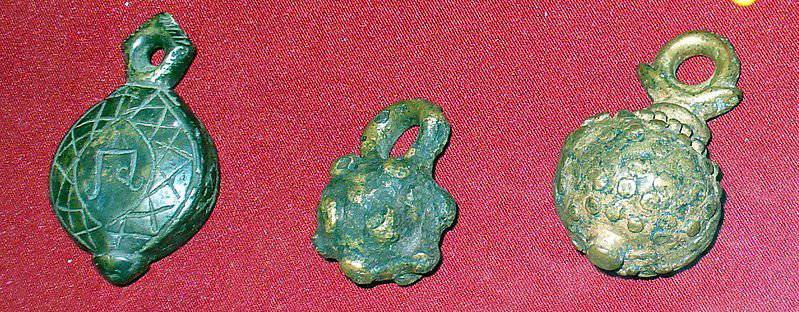
Bronze weights of tassels, Novgorod, XI — XIII c.
A. N. Kirpichnikov distinguishes six main types of brushes for the 10th - 13th centuries. The first is bone weights, often egg-shaped. They were usually made of elk horn - dense and heavy bone and weighed 100 — 250 grams. In a hole, in some cases, an iron rod was inserted, on one side of which a rivet was made, and on the other, a loop for attaching to the hanger. This type was common before the 13 century, when it was supplanted by metal weights. The second - metal (bronze or iron) weights are spherical, pear-shaped and teardrop-shaped, with a smooth, less often - faceted warhead (their weight is about. 60 - 270 g). These tassels were common in the 10-13 centuries. The subtype (type IIA) of these brushes is distinguished by a spherical warhead with bulges. Weights are cast from bronze, inside are filled with lead (weight 120 — 235 g). The third is a pear-shaped weights, flattened from two sides, and a bimetallic structure. Giri consisted of a bronze case filled with lead, and a small stone was put inside (weight 200 - 300 g). A subtype of this weapon is round bronze weights (weight - 160 — 200 grams). Notable for the presence of jewelry. Some weights black ornament, images, inscriptions and even gilding. The fourth type - iron or copper drum parts made in the form of a cube with cut corners, to each face of which a large hemispherical protrusion is soldered, and provided with a rectangular loop for suspension. The fifth one is bronze weights, a warhead in the form of a cube, where on every face, except the top, there is a massive spike, and on each vertex there is a small spike. As a result, the shock load has 5 large and 8 small spikes. The sixth type is biconical shock iron weights.
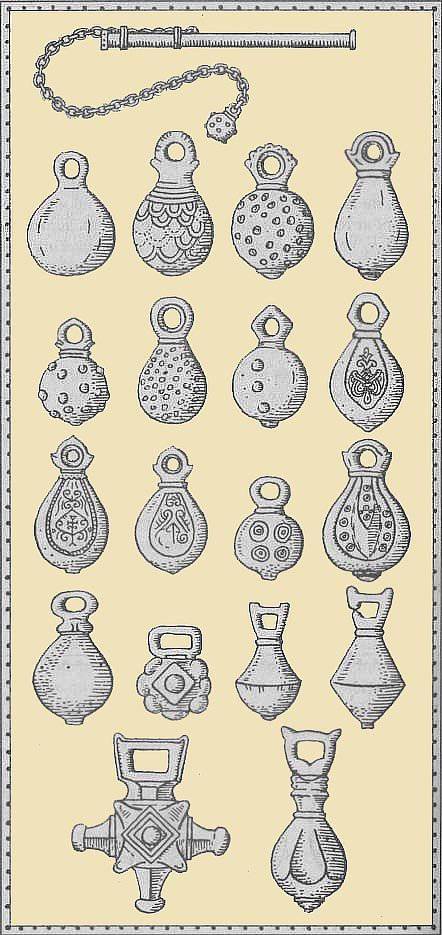
Iron and bronze tins. X – XIII century.
Bow and arrows
The ranged weapon of the Russian soldiers was a bow. This readily available weapon was widely distributed in Russia. Arrowheads - one of the most massive finds in ancient settlements and burial grounds. Occasionally there are fragments of the bows themselves, which allow to draw conclusions about their design and manufacturing technology.
Bows around the world are divided into simple and compound (complex). A simple onion is made from a single piece of wood. In addition, simple onions could be strengthened with tendons, horns. Complex bows (or composite, composite) were assembled from several parts and also had additional reinforcements.
When an ordinary person, not familiar with the topic, starts talking about archers, the art of archery, they usually remember the "good old England" and its "Robin Hoods". Robin Hood and the "incomparable" archers of the English Middle Ages, sung in historical novels by Arthur Conan Doyle (like "The White Squad"), Walter Scott left a serious mark on our culture. However, if we take the data of archeology and written sources, they show that Medieval Western Europe, including England, used mainly a simple bow.
So, in England, a large bow or long bow was common (English longbow), it was about the height of a tall man - 180 — 220, see. English bows were mostly made from a single piece of yew. In addition, other wood species were used less often - elm, ash, hazel, oak. The string of hemp, sometimes made of silk and covered with wax, to protect against moisture. According to researchers, the distance of a direct shot at a long bow was limited to 30-40 m, and an experienced archer could precisely shoot at a distance of 91-92 m. At such a distance an arrow could hit a warrior in mail. And in plate armor - no more than 60 m. In 1982, archeologists managed to lift the remains of Mary Rose rose from 1545 in the year of Henry VIII's carrot (1509 — 1547) from the bottom of the Solent. On board found more than a hundred longbows. Reconstruction of one of the bows found on this vessel made it possible to establish the maximum range of English longbows: an arrow weighing 53,6 g flew at a distance of 328 m, and with a weight of 95,9 g - almost 250 m. However, at this range they lost penetrating power, and the shot was untargeted.
The Slavs, like other peoples of Asia, inherited complex (compound) bows from the Scythians and Huns. They were armed with other Asian peoples - the Turkic tribes, the "Mongols". This bow was shorter - 120 — 130 cm and allowed to shoot from a horse. The tactics of equestrian combat with the massive use of onions have been worked out since the days of the Scythians and have not undergone major changes up to the Middle Ages. "Scythian shot" was that the cavalry was approaching the enemy with lava, showered him with arrows, and then the horsemen turned back while continuing to fire, sitting with their backs to the enemy and turning around in the saddle.
Therefore, Russian bows surpassed Western European in terms of their technical excellence and combat effectiveness. This is evidenced by the range of the shot. If the marginal distance of the aimed shooting of the English archers 91-92 m, then in Russia there was a measure of length - “shooting” (“shooting”) equal to about 225 meters. For comparison, in the Arabian East, where complex bows were also in use, the greatest distance of aimed shooting for ordinary shooters was about 150 m. In addition, complex bows had more powerful penetrating power. For example, English archers with bodkin type arrows (needle-type arrowhead, lit. sewed in English), which had great penetrating power, but less lethal, had chances to hit enemy warriors in chain mail from a distance of about 100 m, and in lamellar armor - not more than 60 m, provided the boom is hit at a right angle and the presence of bad armor. At the same time, the enemy did not necessarily die - when the bodkin hit, the wound is already, and blood loss is less. In addition, the penetration of chain mail or plate armor did not mean that the enemy was wounded, because under the protective arms of the warrior was a dense podstapeshn, also had good protective qualities. The “Mongolian” bows (in Russia they were similar), according to historical sources, pierced through the Western European latniks through. In addition, they used the tactics of the Scythians, as a result, the European knights had little chance against them. This is confirmed by the victories of the army of Batu and his commanders.
From the Livonian chronicles of the XIII century. it is known that in the Russian army there were special detachments of archers. Their task was not only to guard the rati on the march, but to take on the first blow of the enemy, to upset his ranks. Heinrich of Latvia notes the high skill of the Russian shooters in the fight against the German knights. Reports the immense power of Russian bows - their arrows pierced the armor of knights-crusaders. Earlier, the Byzantine historian of the 10th century told about the high skill of the Russian archers. Leo the Deacon. He noted that in the army of Prince Svyatoslav, archers played a large role.
The Russian complex bow successfully survived in the arsenal of local cavalry up to the 17 century. I must say that at the same time simple bows existed in Russia. Usually they were used as hunting weapons. In addition, from the excavations of ancient Russian settlements we know of small children's bows, made from a single piece of wood. A simple bow, or rather its fragment, is found in the ancient layers of Old Ladoga. It belongs in the 8 century. The reconstruction suggests that the length was equal to 130-140, see. An important archaeological find was made in Veliky Novgorod. A well-preserved fragment of the complex bow of the 13 century was found there. Novgorod bow was made of two slats - birch and juniper. Tendons were laid along the back of the bow. Then the whole onion is glued with boiled bark. The components of the Russian onion, like those of other Eastern peoples, had their own names. Thus, the middle of the bow was called the hilt, the long elastic parts on either side of the hilt — the bows of the bow (or horns), the ends were the ends with cutouts for the strings of the bowstring. The side of the bow, which was turned to the target during the shooting, was called the back, and the side facing the shooter was called the inner side (or belly). Places of joints of individual parts (warp with ends, handles with shoulders, etc.) were fixed by winding tendon threads, it was called knots (A. Medvedev. Hand throwing weapon (bow and arrows, self-propelling) of the VIII - XIV century).
Bowstrings for ancient Russian bows were made of various materials. So besides flax, hemp, silk, tendons, the Slavs knew “intestinal strings” - specially treated animal intestines. Rawhide bowstrings were also used. The bowstring was placed just before the fight, and in the campaign they were kept in a special tie pocket on the bow case.
The arrows of the ancient Russian warriors reached in length up to 80-90, they weighed around 50. They were made as follows. A log of coniferous wood (they tried to choose old trees, their wood was denser, harder and stronger) was cut into strips, from these planks they were jigging arrows, the shaft should have been cigar-shaped (slightly thinner towards the ends and thicker in the middle). This form helped the arrow to better overcome air resistance. To stabilize the flight, an arrow was supplied with feathering, usually using feathers of waterfowl. At the feathered end, an eyelet was cut for a string, and a tip was attached at the other end.
Russian arrowheads were very diverse. Many have a diamond shape, there are lanceolate, widening, resembling sharpened scapula cuts (typical hunting tips), tips with spikes extending backwards, trihedral armor-piercing, etc. The tips were attached to the pole with a thin petiole.
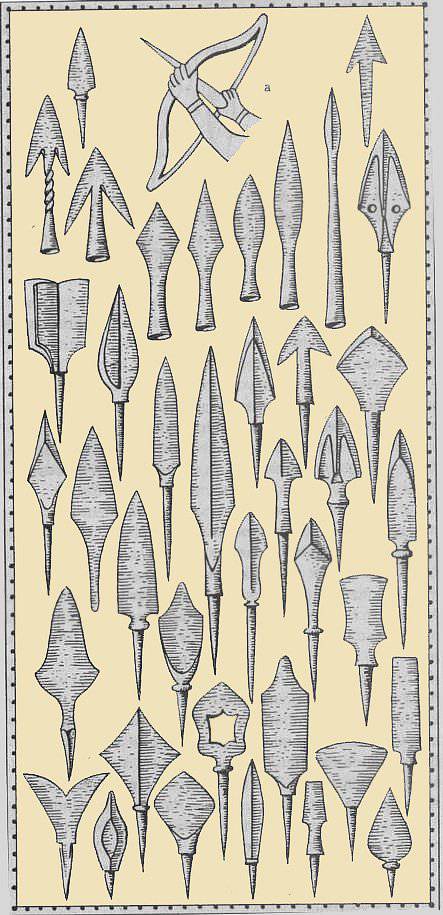
but. The image of a bow on a carved stone of Dmitrievsky Cathedral (XII century) in Vladimir.
Iron and steel arrowheads. IX century
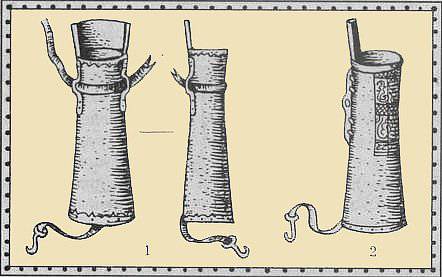
1. Leather tul (straight and side view). X century.
2. Leather tulle with bone ornamental plate. The loops for hanging the body to the belt and the hook for fastening it when riding are clearly visible. XI century.
The arrows were stored in boom cases - “Tulah” (later called “quiver”). Tula usually were cylindrical form. These were rather narrow, downwardly expanding cases of leather, wood, or one or two layers of dense bark (they could be covered with leather). The bottom was wooden, about 1 thickness, see. The length of the body was 60 - 70 cm, it was placed around 20 arrows. Starting from the 12th century, flat tula also appeared. Russian warriors, horse and foot, wore tul to the right of the belt, on a waist belt or flip over a shoulder. And so that the neck of the quiver looked forward. The warrior had to grab an arrow as quickly as possible, his life depended on it.
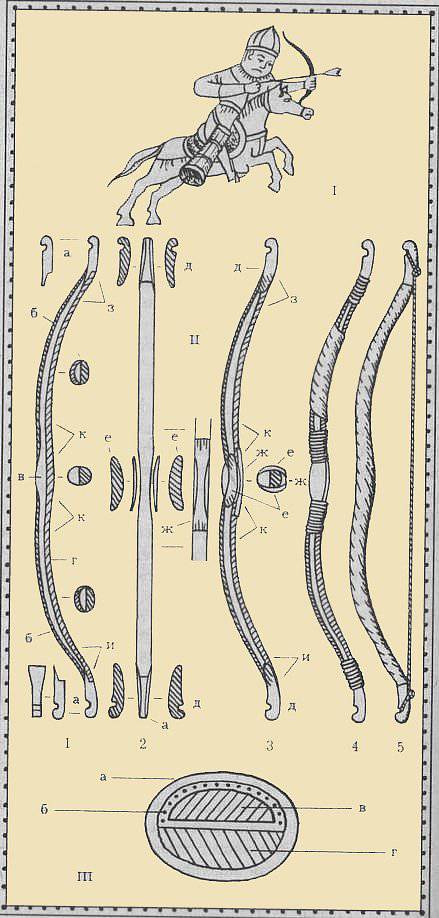
I. Horse Russian Archer. From miniatures of Manasein annals. X century
Ii. Old Russian complex bow: 1. Wooden base of onions. 2. View of the wooden base of the bow from the inside and the layout of the bone patches on it. 3. Arrangement of bone patches on the bow (side view): a - ends with a cutout for a bowstring, b - tendons, b - a birch plank, d - a juniper plank, d - end plates with a cutout for a bowstring, e - side handles of the handle, w lower lining of the handle on the inside of the bow, h, and - knot, or the junction of the ends, slats and tendons, k - the knot, or junction of the tendons and bone linings of the hilt of the bow. 4. Fastening the joints of onion parts by winding glue with tendon threads and gluing on the bark onions. 5. Bow with a bowstring after pasting.
Iii. Onion incision: a - birch bark, b - tendons, in - birch plank, d - juniper plank.
To be continued ...
Information